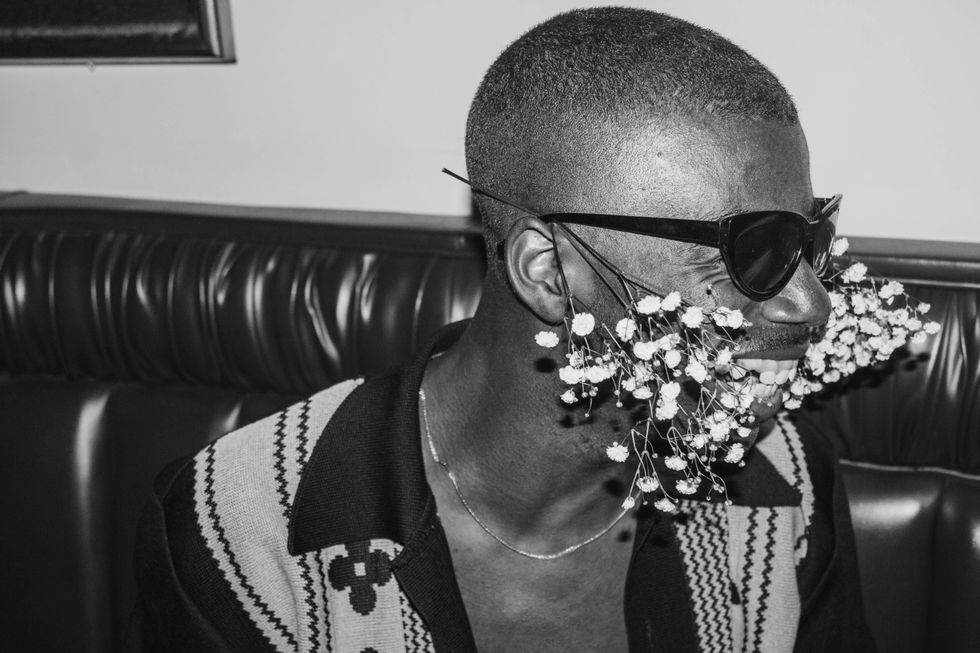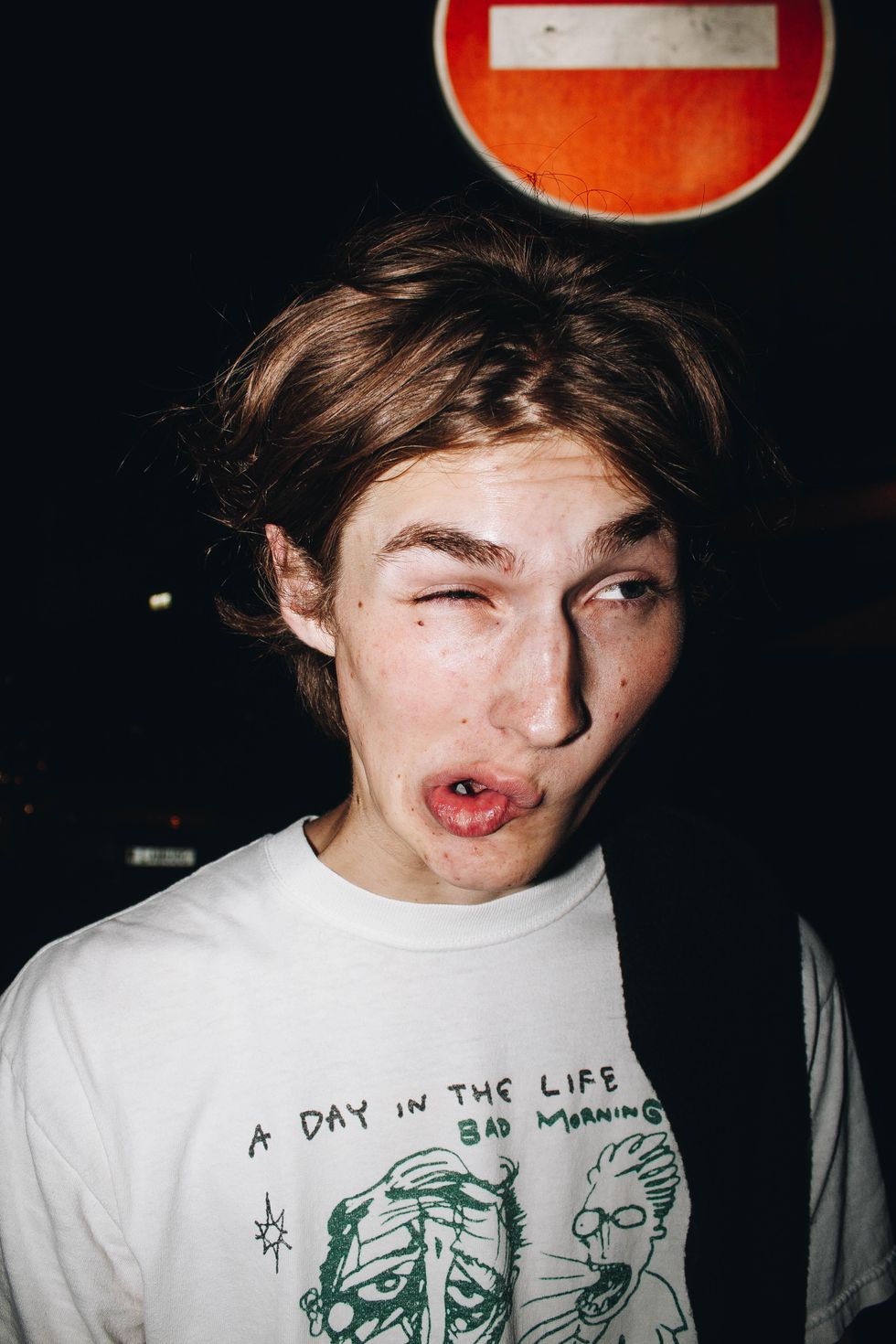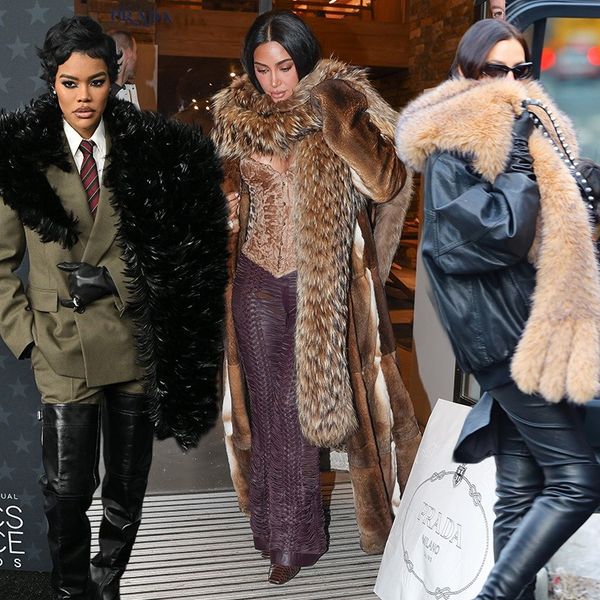
The flash of a camera is a magical thing. In the dark depths of a nightclub, that flash illuminates the jubilation but only for an instant, so the image leaves the viewer curious. Photographer Tyrell Hampton will argue that this untethered depiction of freeze dance tells you everything you need to know. His work captures fashion’s elite at their leisure. A stolen glance, a forbidden act, rush of emotion. This is what the dissolution of boundaries looks like.
In his new exhibit Go Home at the SN37 Gallery (open through January 30), the winner of the first-ever Bal Harbour Shops Emerging Fashion Photography Award and the brain behind China Chalet: Memories takes us with him inside the clubs of New York so that we can experience his mystical journey underground and through the rabbit hole.
The 24-year-old grew up in a dance studio and spent his off time glued to screens—movies, TV shows, and the internet. Though magazines provided his initial taste of editorial imagery, Tumblr honed his eye at a much faster rate. So when his parents discouraged him from pursuing dance as a career, photography seemed like the natural alternative.
By day, Hampton attended Parsons, learning about photos in a traditional classroom setting. By night, he studied through the lens of a camera, which accompanied him everywhere he went with his newfound friends. “I started going out in New York and taking photos of people that I knew in the club or out and about. I just felt that those moments spoke more to me than any other moment while I was finding my voice in imagery.”

Similar to the pandemic-induced desperation currently plaguing many of us, Hampton’s sense of missing out fueled his embrace of nightlife. His youthful milestones were different from the traditional teenager’s and focused more on achievement and less on connection—or as Hampton puts it, making friends. Since then, he’s fostered real relationships with his subjects. Those connections advance him from a straightforward documentarian and make these images personal.
The photographer likens his own role to more of a voyeur. A behavior I characterized as a fly on the wall, he thinks is more so a kid in a candy store. Here was a space that emphasized freedom and contradicted the rigid choreography Hampton was raised on. Though many of his model friends/muses are no strangers to a photoshoot, they aren’t typically conducting one in a nightclub. “A model [is] comfortable around a camera but in a vulnerable state of going out, most people aren't really used to having their photo taken so, I guess, shockingly,” he posits.
Now, Hampton’s working on retaining that shock value despite his newfound wanted presence. “Sometimes I'll just do a lap around the club. This is my time to be incognito.” That candid lack of a pose allows Hampton to capture his subject in motion. Sure, this fascination harkens back to his dance training, but the young photographer will tell you there’s another source.
After glitches accumulated from extreme airtime, Hampton’s childhood-favorite Spy Kids DVDs were prone to freezing. “I would treasure those moments, how it froze and how movement looks when a moment is paused or a little blurry.” The result is images that aren’t always “pretty” in the traditional sense of the term.
“There have been so many times where people have been like, ‘I hate this image. Take this off the internet. Why would you do this to me?’ I just don't respond,” he elaborates. “Not out of disrespect, but I just want them to take a second and re-evaluate what they're looking at. There's beauty in everything, and I think that there's beauty in the ugly things and there's beauty in being free.”

In an ironic turn of phrase that would befuddle the Raegan administration, the Philadelphia native repeatedly refers to the club scene as safe. Safe and free. That blanket of darkness provides a refuge for those who may not feel as accepted in the light of day. “It's not like I don't see these people during the day, but I think at night there's such a freedom of the club that's more so about having a sense of community and awareness and safety. Even if I'm going out with one or two friends, we're going to run into people that we know, that we're comfortable around, that we feel safe around. It's a reunion every time we come out.”
As someone fresh off a screening of the new Studio 54 documentary, I couldn’t help but notice a certain likeness in energy. “When you think about Studio 54,” Hampton humors me, “the only reason why those images worked is because the people knew each other. Even though they were famous, they knew each other. It's more about the connection you saw between Bianca Jagger and random people in the space. Friends and family discount. It was about the friends and family discount.”
In his eyes, the club is more a state of mind than a locale, a notion Hampton had to exercise throughout the past two years. “During the pandemic, we can't really do that much, but we can go to the huge skate park and sit around each other. It's more about that aura and that energy exchange rather than going out to the club and trying to get drunk and stuff.”
Ironically, Hampton doesn’t drink, do drugs, or partake in any illicit substances. His pregame vice of choice? Oreo cookies. He’s high on life (and sugar).
Photos: Courtesy of Tyrell Hampton
Want more stories like this?
Quil Lemons Takes Photographs That Speak the Truth
Inside the Mind of Fashion Photographer Lia Clay Miller
Mark Seliger on the Role of Fashion in His Photography




